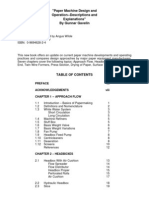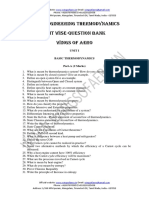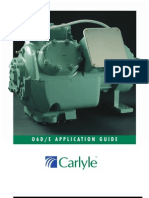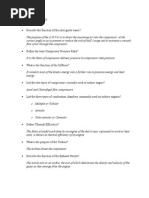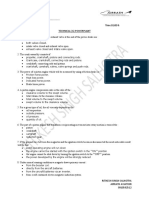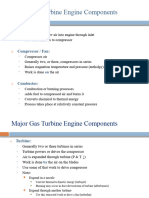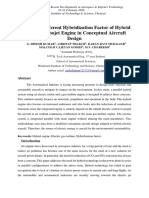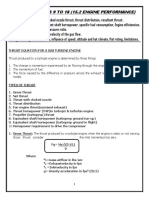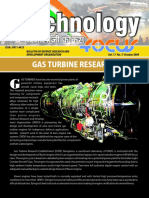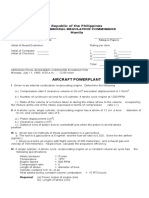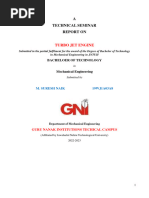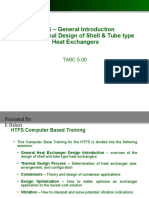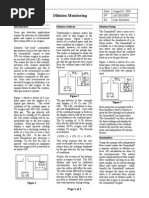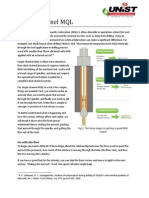Propulsion Lab Manual
Propulsion Lab Manual
Uploaded by
Suthan RCopyright:
Available Formats
Propulsion Lab Manual
Propulsion Lab Manual
Uploaded by
Suthan ROriginal Description:
Original Title
Copyright
Available Formats
Share this document
Did you find this document useful?
Is this content inappropriate?
Copyright:
Available Formats
Propulsion Lab Manual
Propulsion Lab Manual
Uploaded by
Suthan RCopyright:
Available Formats
PROPULSION LAB MANUAL
EXPERIMENT NO-1
STUDY OF AN AIRCRAFT PISTON ENGINE
Aim: To study the various components, their function and operating principles of an aircraft
piston engine.
Apparatus: In-line type 3-cylinder reciprocating engine (petrol)
Theory:
Piston engine components and their functions:
Cylinder –A cylindrical vessel in which the
piston makes the reciprocatory motion.
Combustion chamber-The space enclosed in
the upper part of cylinder covered by the
cylinder head and the piston top during the
combustion process.
Connecting rod-It connects the piston and the
crank shaft and transmits the forces from the
piston to the crank shaft i.e. reciprocating
motion is converted into rotary motion.
Crankshaft-It converts the reciprocating
motion of the piston into useful rotary motion
of output shaft.
Exhaust manifold-The conduit which connects
the exhaust system to exhaust valve of the
engine through which the products of
combustion escape into the atmosphere.
Inlet and exhaust valves-These valves are commonly mushroom shaped poppet type.They
regulate the charge coming into the cylinder and for discharging the products of combustion
from the cylinder.
Inlet manifold-The conduit which connects the intake system to inlet valve of the engine
through which air or air fuel mixture is drawn into the cylinder.
Piston-A cylindrical component fitted into the cylinder forming the moving boundary of the
combustion system.
Suthan R Department of Aeronautical Engg
Asst.Professor NMIT,Bangalore. 1 Page 1
PROPULSION LAB MANUAL
Piston rings-Piston rings, fitted into the slots around the piston, provide a tight seal between the
piston and the cylinder wall thus preventing leakage of the combustion gases.
Spark plug-It initiates the combustion process in spark ignition engines and is usually located on
the cylinder head.
Working principle
All internal combustion engines have a certain sequence of events that must take place to convert
the chemical energy in the fuel into
mechanical work.
Intake Stroke: As the name suggests in
this stroke the intake of fuel takes place.
When the engine starts, the piston
descends to the cylinder's bottom from
the top. Thus the pressure inside the
cylinder reduces. Now the intake valve
opens and the fuel and air mixture enters
the cylinder. The valve then closes.
Compression Stroke: This stroke is
known as compression stroke because
the compression of the fuel mixture
takes place at this stage. When the
intake valve closes (exhaust valve is
already closed), the piston forced back
to the top of the cylinder and the fuel
mixture gets compressed. The
compression is around 1/8th of the
original volume. An engine is
considered more efficient if its compression ratio is higher.
Suthan R Department of Aeronautical Engg
Asst.Professor NMIT,Bangalore. 2 Page 2
PROPULSION LAB MANUAL
Combustion/Power Stroke: Now in case of petrol engine when the fuel mixture compresses to
the maximum value the spark plug produces spark which ignites the fuel mixture. The
combustion leads to the production of high pressure gases. Due to this tremendous force the
piston is driven back to the bottom of the cylinder. As the piston moves downwards, the
crankshaft rotates which rotates the propeller of an aircraft.
Exhaust Stroke: As the wheel moves to the bottom the exhaust valve opens up and due to the
momentum gained by the wheel the piston is pushed back to the top of the cylinder. The gases
due to combustion are hence expelled out of the cylinder into the atmosphere through the exhaust
valve.
The exhaust valve closes after the exhaust stroke and again the intake valve opens and the four
strokes are repeated.
Conclusion:
Thus the components and their function of piston engine have been studied.
Suthan R Department of Aeronautical Engg
Asst.Professor NMIT,Bangalore. 3 Page 3
PROPULSION LAB MANUAL
SAMPLE VIVA QUESTIONS
1. How we can categorize the aircraft piston engines?
2. What are the important components and their functions?
3. Why we need piston rings around the piston?
4. How reciprocating engine differs from jet engine for aircraft propulsion?
5. Differentiate pre-ignition, detonation and knocking?
6. Draw the ideal and real P-v , T-s diagram for 4stroke petrol engine ?
7. What is the drawback of aircraft piston engine over jet engine?
8. Are IC engines cyclic or non cyclic? Give the reason
9. Differentiate the IP,BP & FP ?
10. What is the physical significance of valve timing diagram?
Suthan R Department of Aeronautical Engg
Asst.Professor NMIT,Bangalore. 4 Page 4
PROPULSION LAB MANUAL
EXPERIMENT NO-2
STUDY OF AN AIRCRAFT JET ENGINE
Aim: To study the various components, their function and operating principles of an aircraft jet
engine.
Apparatus: MIG -21 R13-300 Turbojet with Afterburner Engine.
Specifications:
Type Turbojet with Afterburner
Length 4.6 m
Diameter Max 906mm,Inlet dia 690 mm
Compressor Twin spool,3LP and 5HP
Combustor Can annular type(10 can with duplex injector)
Turbine Two stage reaction(1HP and 1LP)
Nozzle Variable Area nozzle
Max. compression ratio 8.9
Turbine inlet temperature 10250C
SFC 0.0978 kg/N h, 0.229 kg/N h with Additional combustion
Max.Thrust 40221 KN, With Auxiliary combustion 64746 KN
Air supply 67 kg/s
Theory:
A turbojet engine consists of the following sections and systems:
Air intake section
Compressor section
Combustion section
Turbine section
Exhaust section
Accessory section(Systems necessary for starting, lubrication, fuel supply, and auxiliary
purposes, such as anti-icing, cooling, and afterburning)
Suthan R Department of Aeronautical Engg
Asst.Professor NMIT,Bangalore. 5 Page 5
PROPULSION LAB MANUAL
AIR INTAKE SECTION
The air intake section directs incoming air to the compressor entrance with a minimum of
energy loss. Additionally, it must deliver this air under all flight conditions with as little
turbulence and pressure variation as possible. Normally, the engine inlet is part of the airframe.
Proper duct design contributes to aircraft performance by increasing ram recovery and limiting
pressure drops. Divergent inlet designs changes ram air velocity into high static pressure at the
compressor inlet.
Two methods of classifying inlet ducts are as follows:
Single entrance and divided entrance
Subsonic and supersonic ducts
COMPRESSOR SECTION
The primary function of the compressor is to supply air in enough quantity to satisfy the
requirements of the combustion burners. Specifically, the compressor increases the air mass
received from the air inlet duct and directs it to the burners in the quantity and at the pressures
required. A secondary function is to supply compressor bleed air for various purposes in the
engine and aircraft. The compressor provides space for mounting accessories and engine parts.
There are two basic types of compressors.
Centrifugal-flow compressors have a compression ratio of 5:1.
Axial flow compressors have compression ratios approaching 15:1
Suthan R Department of Aeronautical Engg
Asst.Professor NMIT,Bangalore. 6 Page 6
PROPULSION LAB MANUAL
Modern jet engine uses a axial-flow compressor which has two main element
Rotor
Stator.
Each consecutive pair of rotor and stator blades makes a pressure stage. The rotor is a shaft
with blades attached to it. These blades impel air rearward in the same manner as a propeller, by
reason of their angle and airfoil contour.. The action of the rotor increases the compression of the
air. At each stage it accelerates rearward. The stator blades act as diffusers, partially converting
high velocity to pressure. Maintaining high efficiency requires small changes in the rate of
diffusion at each stage. The number of stages depends on the amount of air and total pressure rise
required. A greater number of stages means a higher compression ratio. Most present day
engines use from 10 to 16 stages.
COMBUSTION SECTION
The combustion section provides the means for and houses the combustion process. Its
function is to raise the temperature of the air passing through the engine. This process releases
energy contained in the air and fuel.
The primary considerations in burning the fuel-air mixture include:
Providing the means for proper mixing of the fuel and air to assure good combustion.
Burning this mixture efficiently.
Cooling the hot combustion products to a temperature that the turbine blades can
withstand under operating conditions.
Directing the hot gases to the turbine section.
About one-fourth of the air entering the combustion chamber area mixes with the fuel for
combustion. This is primary air. The remaining air (secondary air) serves as flame control.
Keeping the temperature of the heated gases down to a level at which the liners, turbine nozzles,
or blades will not burn. All combustion chambers contain the same basic elements: a casing, a
perforated inner liner, a fuel injection system, some means for initial ignition, and a fuel drainage
system to drain off unburned fuel after engine shutdown.
The three basic types of combustion chambers are as follows:
The multiple chamber, or can.
The annular, or basket.
The can-annular.
Suthan R Department of Aeronautical Engg
Asst.Professor NMIT,Bangalore. 7 Page 7
PROPULSION LAB MANUAL
TURBINE SECTION
The turbine transforms a portion of the kinetic (velocity) energy of the exhaust gases into
mechanical energy to drive the compressor and necessary accessories. This is the sole purpose of
the turbine. This function absorbs about 60 to 80 percent of the total pressure energy from the
exhaust gases. The exact amount of energy absorption at the turbine is determined by the load
the turbine is driving. The compressor size, type, accessories, and a propeller and its reduction
gears if the engine is a turbo-propeller type, also affect absorption.
The turbine assembly consists of two basic elements
stator
rotor
The stationary vanes of the turbine nozzle are contoured and set at such an angle that they
form small nozzles. They discharge the gas as extremely high-speed jets. Thus, the nozzle
converts a varying portion of the heat and pressure energy to velocity energy. It can then be
converted to mechanical energy through the rotor blades. The second purpose of the turbine
nozzle is to deflect the gases to a specific angle in the direction of turbine wheel rotation. Since
the gas flow from the nozzle must enter the turbine blade passageway while the turbine is still
rotating, it is essential to aim the gas in the general direction of turbine rotation.
There are two types of turbine stages
Impulse stage turbine
Reaction stage turbine
Suthan R Department of Aeronautical Engg
Asst.Professor NMIT,Bangalore. 8 Page 8
PROPULSION LAB MANUAL
AFTERBURNER SECTION
Fighter aircrafts require more thrust for short take off and Emergency situations. For
those application, Engine will have a component called Afterburner. Actually, it is more like a
converted tailpipe. The entire afterburner is projected from the engine. It is supported only at the
exhaust end where it is bolted to the engine.
Since the duct acts as a burner, the
inlet air velocity must be sufficiently low to
support stable combustion and to avoid
excessive pressure losses. For these
purposes a diffuser is located between the
turbine outlet and the tailpipe burner inlet.
Thus, the burner section of the duct can
reduce gas velocities so they do not exceed
the flame propagation rate. Mixing by
diffusion is too slow a process to be an aid
in forming a combustible mixture. The
flame holders provide local turbulence and
reduce velocity, which aids combustion
stability. The flame holders are located
downstream from the fuel-injection nozzles,
Additional energy is given to the exhaust gases by burning additional fuel sprayed in the exhaust
stream aft of the turbine.
EXHAUST SECTION
The exhaust section of the turbojet engine is made up of several parts, each of which has
its individual functions.. They must direct the flow of hot gases rearward in such a manner as to
prevent turbulence, while causing a high final or exit velocity to the gases.
The parts of the exhaust section include the exhaust cone, tailpipe (if required), and the
exhaust, or jet nozzle. The exhaust cone collects
the exhaust gases discharged from the turbine
assembly and gradually converts them into a solid
jet. During this operation, the velocity of the gases
will decrease slightly, and the pressure will
increase. This is caused by the diverging passage
between the outer duct and the inner cone. This
element collects and delivers the exhaust gases.
The gases flow either directly or through a tailpipe
to the jet nozzle, depending on whether or not a
tailpipe is required. There is no need for a tailpipe
in some engines
There are two types of jet nozzle design.
Converging design, used on most freed-area nozzles for subsonic velocities
Converging/diverging design, for supersonic gas velocities.
Suthan R Department of Aeronautical Engg
Asst.Professor NMIT,Bangalore. 9 Page 9
PROPULSION LAB MANUAL
ACCESSORY SECTION
. The primary function is to provide space for the mounting of accessories necessary for
the operation and control of the engine. It also includes accessories concerned with the aircraft,
such as electric generators and fluid power pumps. The secondary purpose includes acting as an
oil reservoir, oil sump, and providing for and housing of accessory drive gears and reduction
gears.. The accessories on engines are the fuel control with its governing device, the high-
pressure fuel pump(s), and a breather screen or other means for venting the oil system. Other
parts are the oil sump, oil pressure and scavenge pumps, auxiliary fuel pump, starting fuel pump,
and other accessories, including starter, generator, and tachometer. Although these accessories
are essential, the particular combination of engine driven accessories depends upon the use for
which the engine is designed.
WORKING PRINCIPLE
Air taken in from an opening in the front of the engine is compressed to 3 to 12 times its
original pressure in compressor. Fuel is added to the air and burned in a combustion chamber to
raise the temperature of the fluid mixture to about 1,100°F to 1,300° F. The resulting hot air is
passed through a turbine, which drives the compressor. If the turbine and compressor are
efficient, the pressure at the turbine discharge will be nearly twice the atmospheric pressure, and
this excess pressure is sent to the nozzle to produce a high-velocity stream of gas which produces
a thrust. Substantial increases in thrust can be obtained by employing an afterburner. It is a
second combustion chamber positioned after the turbine and before the nozzle. The afterburner
increases the temperature of the gas ahead of the nozzle. The result of this increase in
temperature is an increase of about 40 percent in thrust at takeoff and a much larger percentage
at high speeds once the plane is in the air.
Conclusion:
Thus the construction, working principle and components of gas turbine engine have
been studied.
Suthan R Department of Aeronautical Engg
Asst.Professor NMIT,Bangalore. 10 Page 10
PROPULSION LAB MANUAL
SAMPLE VIVA QUESTIONS
1. What are the different gas turbine engines?
2. What is the operating cycle of a gas turbine engine? Explain each process?
3. Clarify the flow separation, stalling and surging in compressor?
4. What are the different types of combustion chambers used, compare it?
5. Explain the importance of liners in combustor?
6. What is the material consideration to be followed for compressor and turbine?
7. Why we need a diffuser and a nozzle?
8. Difference between axial flow compressor and centrifugal compressor?
9. What are the main combustion products of a GTE? How we can reduce it?
10. How GTE is different from piston engine?
Suthan R Department of Aeronautical Engg
Asst.Professor NMIT,Bangalore. 11 Page 11
You might also like
- Paper Machine Design and OperationDocument10 pagesPaper Machine Design and OperationArtesira Yuna58% (26)
- Numerical Questions - Airbreathing EngineDocument2 pagesNumerical Questions - Airbreathing EngineDhiraj NayakNo ratings yet
- Aero Engineering Thermodynamics PDFDocument22 pagesAero Engineering Thermodynamics PDFSridharanNo ratings yet
- Carlyle Compressor O6D/EDocument72 pagesCarlyle Compressor O6D/Erlynch33100% (6)
- Pumps Selection LectureDocument59 pagesPumps Selection Lectureshicardinal100% (5)
- Thermodynamic Relations - Applications - v44 - P4Document40 pagesThermodynamic Relations - Applications - v44 - P4Santiago Cardona ArroyaveNo ratings yet
- Aemr Two MarksDocument11 pagesAemr Two MarksRajashree VenugopalNo ratings yet
- EASA Mod 15 BK 9 Heli EngsDocument45 pagesEASA Mod 15 BK 9 Heli Engsavi100% (2)
- Lecture 01 - Introduction To Aircraft PropulsionDocument28 pagesLecture 01 - Introduction To Aircraft PropulsionandriaerospaceNo ratings yet
- Reviewer 5Document59 pagesReviewer 5KleberNo ratings yet
- IC EnginesDocument14 pagesIC EnginesPradeep N B100% (1)
- An Introduction To Jet Propulsion (Mme 4071 PPT-1)Document20 pagesAn Introduction To Jet Propulsion (Mme 4071 PPT-1)Peter GeorgeNo ratings yet
- Department of Aeronautical / Aerospace Engineering U20AE301 - Aero Engineering Thermodynamics 50 Big QuestionsDocument8 pagesDepartment of Aeronautical / Aerospace Engineering U20AE301 - Aero Engineering Thermodynamics 50 Big QuestionsGurunath AeroNo ratings yet
- Theories of Failure - 2marksDocument2 pagesTheories of Failure - 2marksBas KaranNo ratings yet
- Module 5 Aircraft Propulsion NotesDocument48 pagesModule 5 Aircraft Propulsion NotesPratham M JariwalaNo ratings yet
- Engine Testing LabDocument3 pagesEngine Testing LabSachi MensiNo ratings yet
- Turbine QuestionsDocument71 pagesTurbine QuestionsTheStephen Michael BoodhooNo ratings yet
- Dynamic Analysis of Corrugated Control Surface For Flutter SupressionDocument87 pagesDynamic Analysis of Corrugated Control Surface For Flutter SupressionPrashanth TelkarNo ratings yet
- AE6002 Aircraft General Engineering and Maintenance PracticesDocument1 pageAE6002 Aircraft General Engineering and Maintenance PracticesKarthi Keyan50% (2)
- Aero Engine Maintenance and RepairDocument21 pagesAero Engine Maintenance and RepairDurai Raj KumarNo ratings yet
- Answers For Air Conditioning Quiz.Document11 pagesAnswers For Air Conditioning Quiz.Caserta Technical GamerNo ratings yet
- Module 3 IC EnginesDocument70 pagesModule 3 IC EnginesAnkitNo ratings yet
- Module 14 Propulsion Notes-3 PDFDocument5 pagesModule 14 Propulsion Notes-3 PDFastikNo ratings yet
- 1.1 Gas Turbine EngineDocument21 pages1.1 Gas Turbine EngineaarthiNo ratings yet
- Fuel Injection & TurbochargingDocument4 pagesFuel Injection & Turbocharging6 avinashNo ratings yet
- Brayton Cycle Reheat Regen RecollingDocument14 pagesBrayton Cycle Reheat Regen RecollingDaxit LodaliyaNo ratings yet
- Aerospace Propulsion Dept of ANE, MRCET: 2.1:euler's Turbo-Machinery EquationsDocument31 pagesAerospace Propulsion Dept of ANE, MRCET: 2.1:euler's Turbo-Machinery EquationssushmarajagopalNo ratings yet
- Powerplant TestDocument6 pagesPowerplant TestkomilaNo ratings yet
- Chapter III Propulsion Systems Thrust and Performance ParametersDocument29 pagesChapter III Propulsion Systems Thrust and Performance ParametersshmyeNo ratings yet
- Analysis of Different Hybridization Factor of Hybrid Electric Turbojet Engine in Conceptual Aircraft Design PDFDocument9 pagesAnalysis of Different Hybridization Factor of Hybrid Electric Turbojet Engine in Conceptual Aircraft Design PDFAmritap SandilyaNo ratings yet
- Propulsion IIDocument2 pagesPropulsion IIkannanNo ratings yet
- Thermodynamics Lab Manual - SDocument32 pagesThermodynamics Lab Manual - SGurunath AeroNo ratings yet
- ICE Lab ManualDocument68 pagesICE Lab ManualAkhilNagNo ratings yet
- 15.2 Engine PerformanceDocument9 pages15.2 Engine PerformanceAnonymous GhskOM48DNo ratings yet
- Industrial AerodynamicsDocument78 pagesIndustrial AerodynamicsAnuNo ratings yet
- Air Breathing Propulsion Unit-2Document54 pagesAir Breathing Propulsion Unit-2api-271354682No ratings yet
- Assesment Exam (Powerplant)Document18 pagesAssesment Exam (Powerplant)Sealtiel1020No ratings yet
- Aircraft Structures I: Lecture Notes OnDocument23 pagesAircraft Structures I: Lecture Notes OnCjananiNo ratings yet
- Iii Mech Vi Sem QB 2013 2014 Even PDFDocument137 pagesIii Mech Vi Sem QB 2013 2014 Even PDFSiva RamanNo ratings yet
- Methods of Cooling in Liquid RocketDocument5 pagesMethods of Cooling in Liquid RocketrachelNo ratings yet
- Airframe and Powerplant ReviewerDocument45 pagesAirframe and Powerplant ReviewerBobby SereNo ratings yet
- ICE Lab ReportDocument34 pagesICE Lab ReportUmair Ali RajputNo ratings yet
- Numericals On Centrifugal and Axial CompressorsDocument2 pagesNumericals On Centrifugal and Axial CompressorsMoiz Tinwala33% (3)
- MODULE 15 PART-4 QuestionsDocument46 pagesMODULE 15 PART-4 QuestionsSam Sir100% (1)
- Radial TurbinesDocument46 pagesRadial TurbinesarorabbNo ratings yet
- AEMR-Unit - II & III, 2 Marks & 16 Marks Questions With Anwers-IV Yr AeroDocument39 pagesAEMR-Unit - II & III, 2 Marks & 16 Marks Questions With Anwers-IV Yr AeroRAJASUDHAKAR SNo ratings yet
- Design and Analysis of Turbo Jet EngineDocument7 pagesDesign and Analysis of Turbo Jet Enginemohamed.saih7128No ratings yet
- AA007 Aircraft Propulsion Question BankDocument15 pagesAA007 Aircraft Propulsion Question BankZubaran Bautista JuanNo ratings yet
- Elements of Aerospace EngineeringDocument12 pagesElements of Aerospace Engineeringrattan5No ratings yet
- Ae2254 QBDocument13 pagesAe2254 QBMahesh J RaoNo ratings yet
- Assignment 1: Turbo MachinesDocument2 pagesAssignment 1: Turbo MachineskookoNo ratings yet
- Final Power Plant Examination PaperDocument2 pagesFinal Power Plant Examination PaperSafaa Hameed Al Nasery100% (1)
- Technology Technology: Gas Turbine ResearchDocument12 pagesTechnology Technology: Gas Turbine ResearchDR DONo ratings yet
- Aerodynamics-AeroEngineering-MODULE 1Document21 pagesAerodynamics-AeroEngineering-MODULE 1GADDI Noel Jr. N.No ratings yet
- AET Question Bank For AUC R2013 - SDocument5 pagesAET Question Bank For AUC R2013 - SGurunath AeroNo ratings yet
- PRC - Aircraft PowerplantDocument24 pagesPRC - Aircraft PowerplantMommyPokaNo ratings yet
- Module 16-07 Piston Engine: Supercharging and TurbochargingDocument36 pagesModule 16-07 Piston Engine: Supercharging and TurbochargingИлларион ПанасенкоNo ratings yet
- Experimental AerodynamicsDocument2 pagesExperimental AerodynamicsAmal JoyNo ratings yet
- Aircraft Design QuestionsDocument2 pagesAircraft Design QuestionsVijay Gorfad100% (2)
- Turbo Jet EngineDocument22 pagesTurbo Jet Engineb.vishwa.nayakNo ratings yet
- Propulsion 1 Part ADocument6 pagesPropulsion 1 Part Asubha_aeroNo ratings yet
- Unit 4 1Document12 pagesUnit 4 1Surya Teja VuttiNo ratings yet
- Aero Engine - 1504714592213Document75 pagesAero Engine - 1504714592213raviNo ratings yet
- Blooms TaxonomyDocument1 pageBlooms TaxonomySuthan RNo ratings yet
- Introduction To Electric Rocket PropulsionDocument46 pagesIntroduction To Electric Rocket PropulsionSuthan RNo ratings yet
- Basics of Turbomachinery BalanceDocument14 pagesBasics of Turbomachinery BalanceSuthan RNo ratings yet
- Aircraft Accident InvestigationDocument1 pageAircraft Accident InvestigationSuthan RNo ratings yet
- HMTDocument4 pagesHMTSuthan RNo ratings yet
- V-N DiagramDocument2 pagesV-N DiagramSuthan RNo ratings yet
- Rocket Propulsion IntroductionDocument30 pagesRocket Propulsion IntroductionSuthan R100% (2)
- CNR-2S - (1.5,3,5) P-6M Crude & Refined Product Sampler System Support ManualDocument38 pagesCNR-2S - (1.5,3,5) P-6M Crude & Refined Product Sampler System Support ManualDiego Nicolás FERNANDEZNo ratings yet
- Steam Coil SizingDocument21 pagesSteam Coil SizingMildawwg100% (1)
- Compresor Con Turbina de Vapor PDFDocument257 pagesCompresor Con Turbina de Vapor PDFCristhian Cueva100% (1)
- Hydraulic Calculations - Safe RainDocument17 pagesHydraulic Calculations - Safe RainmoisesNo ratings yet
- Gas (3 Files Merged)Document76 pagesGas (3 Files Merged)Mashael 7No ratings yet
- Reservoir Fluids Day 4Document57 pagesReservoir Fluids Day 4Bella cedricNo ratings yet
- List Three Examples of Matter Changing From One State To AnotherDocument31 pagesList Three Examples of Matter Changing From One State To AnotherygjyoNo ratings yet
- Pipe 100 Up (Dated - Docx Version 1Document13 pagesPipe 100 Up (Dated - Docx Version 1AjayBravoNo ratings yet
- Chapter 3 MERE0323 - 2Document4 pagesChapter 3 MERE0323 - 2Estera ShawnNo ratings yet
- Refining ProcessDocument22 pagesRefining Processramadoss_alwar7307No ratings yet
- HTFS Presentation 2Document57 pagesHTFS Presentation 2Divyesh Patel100% (1)
- Tejas Gangan - ResumeDocument1 pageTejas Gangan - Resumeabhijit patilNo ratings yet
- Ch.9 Smoke Control or Fire Stop Protection - ZipDocument3 pagesCh.9 Smoke Control or Fire Stop Protection - ZipDarwin LimNo ratings yet
- Dilution Monitoring-InertDocument1 pageDilution Monitoring-InertgshdavidNo ratings yet
- Pump Minimum Continuous Stable Flow (MCSF)Document6 pagesPump Minimum Continuous Stable Flow (MCSF)mayukhguha1988No ratings yet
- Final Report CPDPDocument16 pagesFinal Report CPDPJunaid BangashNo ratings yet
- Boiler of 500 MWDocument8 pagesBoiler of 500 MWHKVMVPVPV021511No ratings yet
- EGE11B21Document25 pagesEGE11B21Jhonny Rafael Blanco CauraNo ratings yet
- Unist Single Channel MQLDocument7 pagesUnist Single Channel MQLMann Sales & MarketingNo ratings yet
- Carbonation Manual 2Document24 pagesCarbonation Manual 2bobNo ratings yet
- Pressure Vessel DesignDocument33 pagesPressure Vessel DesignUmmu Adani IsmailNo ratings yet
- Pompe SUMO FCB - FIVES - SUGAR - BIOENERGY - SUMO - EN - 290316 - BDDocument4 pagesPompe SUMO FCB - FIVES - SUGAR - BIOENERGY - SUMO - EN - 290316 - BDSAHOMA OMARINo ratings yet
- IFP Materials PDFDocument40 pagesIFP Materials PDFProcess EngineerNo ratings yet
- Advanced Process Control For Optimizing Flue Gas Desulfurization - IIOT ConnectionDocument4 pagesAdvanced Process Control For Optimizing Flue Gas Desulfurization - IIOT ConnectionSaravanan RagupathyNo ratings yet
- Air Conditioner (RHD Manual)Document13 pagesAir Conditioner (RHD Manual)Christian Chicana DiazNo ratings yet
